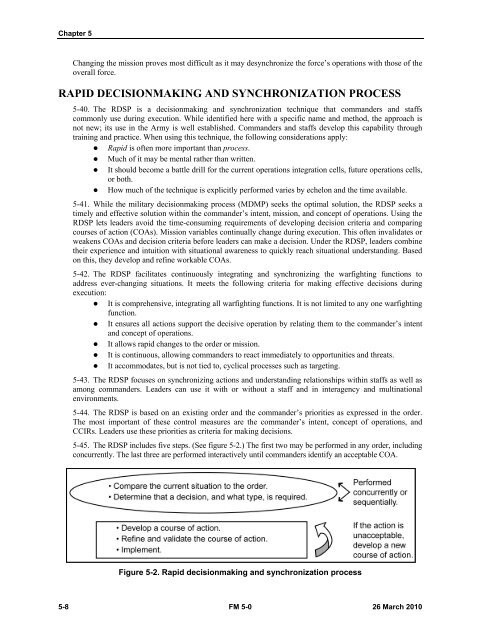FM 5-0, The Operations Process - Federation of American Scientists
FM 5-0, The Operations Process - Federation of American Scientists
FM 5-0, The Operations Process - Federation of American Scientists
You also want an ePaper? Increase the reach of your titles
YUMPU automatically turns print PDFs into web optimized ePapers that Google loves.
Chapter 5<br />
Changing the mission proves most difficult as it may desynchronize the force’s operations with those <strong>of</strong> the<br />
overall force.<br />
RAPID DECISIONMAKING AND SYNCHRONIZATION PROCESS<br />
5-40. <strong>The</strong> RDSP is a decisionmaking and synchronization technique that commanders and staffs<br />
commonly use during execution. While identified here with a specific name and method, the approach is<br />
not new; its use in the Army is well established. Commanders and staffs develop this capability through<br />
training and practice. When using this technique, the following considerations apply:<br />
• Rapid is <strong>of</strong>ten more important than process.<br />
• Much <strong>of</strong> it may be mental rather than written.<br />
• It should become a battle drill for the current operations integration cells, future operations cells,<br />
or both.<br />
• How much <strong>of</strong> the technique is explicitly performed varies by echelon and the time available.<br />
5-41. While the military decisionmaking process (MDMP) seeks the optimal solution, the RDSP seeks a<br />
timely and effective solution within the commander’s intent, mission, and concept <strong>of</strong> operations. Using the<br />
RDSP lets leaders avoid the time-consuming requirements <strong>of</strong> developing decision criteria and comparing<br />
courses <strong>of</strong> action (COAs). Mission variables continually change during execution. This <strong>of</strong>ten invalidates or<br />
weakens COAs and decision criteria before leaders can make a decision. Under the RDSP, leaders combine<br />
their experience and intuition with situational awareness to quickly reach situational understanding. Based<br />
on this, they develop and refine workable COAs.<br />
5-42. <strong>The</strong> RDSP facilitates continuously integrating and synchronizing the warfighting functions to<br />
address ever-changing situations. It meets the following criteria for making effective decisions during<br />
execution:<br />
• It is comprehensive, integrating all warfighting functions. It is not limited to any one warfighting<br />
function.<br />
• It ensures all actions support the decisive operation by relating them to the commander’s intent<br />
and concept <strong>of</strong> operations.<br />
• It allows rapid changes to the order or mission.<br />
• It is continuous, allowing commanders to react immediately to opportunities and threats.<br />
• It accommodates, but is not tied to, cyclical processes such as targeting.<br />
5-43. <strong>The</strong> RDSP focuses on synchronizing actions and understanding relationships within staffs as well as<br />
among commanders. Leaders can use it with or without a staff and in interagency and multinational<br />
environments.<br />
5-44. <strong>The</strong> RDSP is based on an existing order and the commander’s priorities as expressed in the order.<br />
<strong>The</strong> most important <strong>of</strong> these control measures are the commander’s intent, concept <strong>of</strong> operations, and<br />
CCIRs. Leaders use these priorities as criteria for making decisions.<br />
5-45. <strong>The</strong> RDSP includes five steps. (See figure 5-2.) <strong>The</strong> first two may be performed in any order, including<br />
concurrently. <strong>The</strong> last three are performed interactively until commanders identify an acceptable COA.<br />
Figure 5-2. Rapid decisionmaking and synchronization process<br />
5-8 <strong>FM</strong> 5-0 26 March 2010















